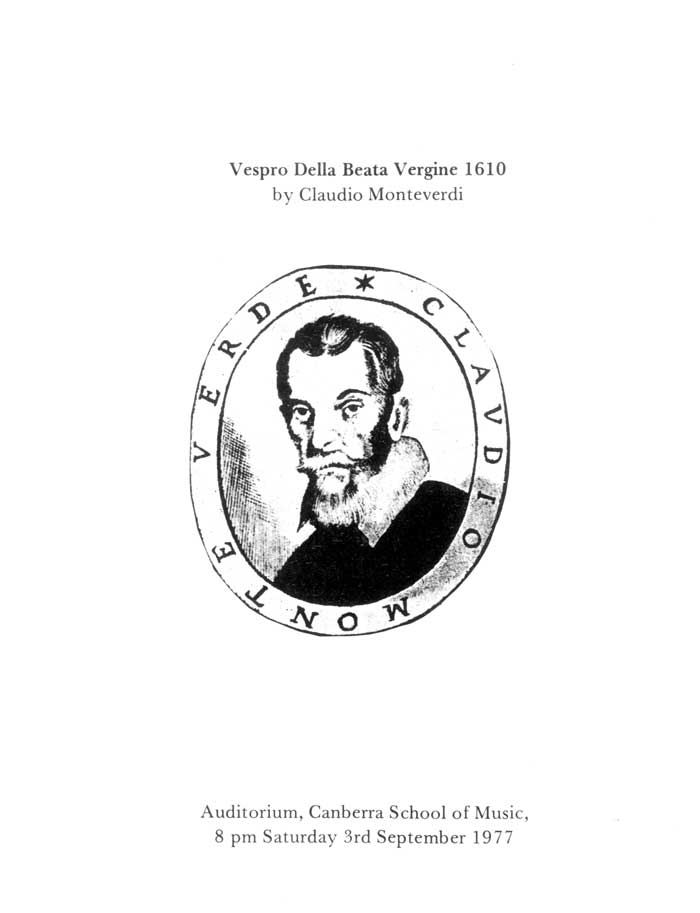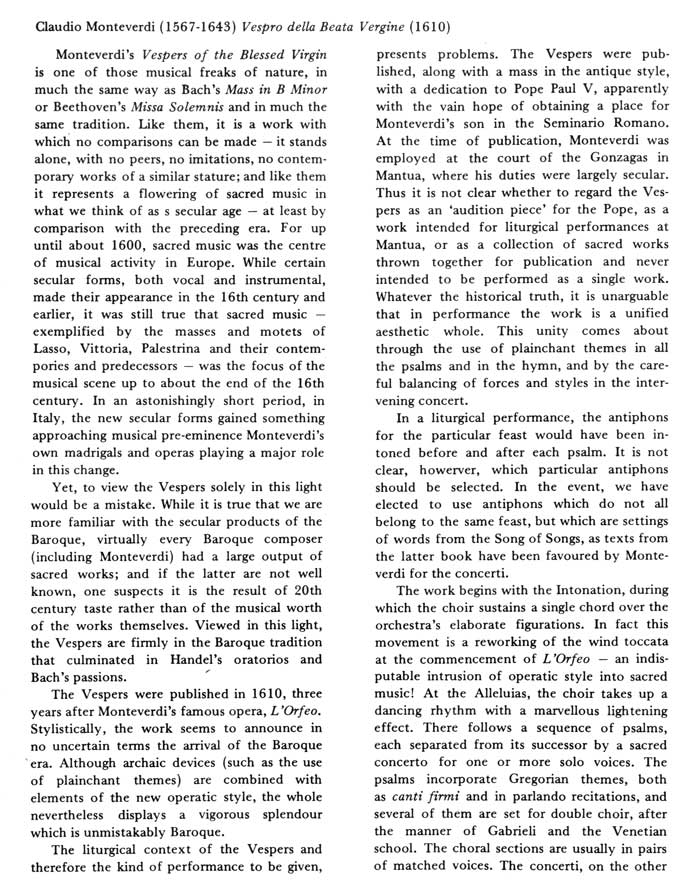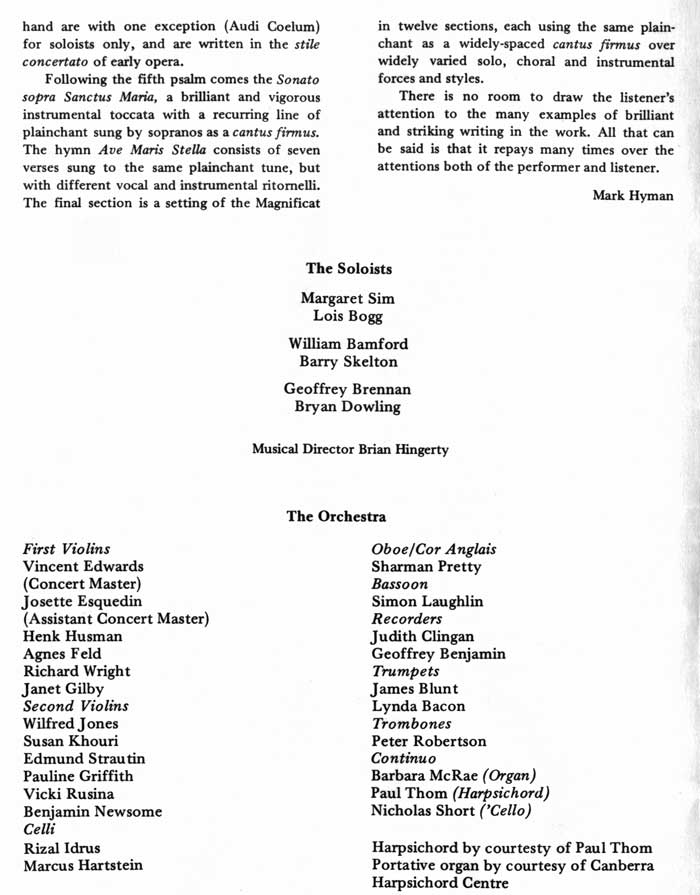

SCUNA history » IVs and Minifests hosted by SCUNA to 1988 » 1977 IV » Programme 3 of 5
On this web page:

by Claudio Monteverdi
[Description of graphic: circle containing portrait of Monteverdi.
Around the outside of the circle, within a concentric circle, is written * CLAUDIO MONTEVERDE.]
Auditorium, Canberra School of Music,
8pm Saturday 3rd September 1977

Monteverdi's Vespers of the Blessed Virgin is one of those musical freaks of nature, in much the same way as Bach's Mass in B Minor or Beethoven's Missa Solemnis and in much the same tradition. Like them, it is a work with which no comparisons can be made - it stands alone, with no peers, no imitations, no contemporary works of a similar stature; and like them it represents a flowering of sacred music in what we think of as a secular age - at least by comparison with the preceding era. For up until about 1600, sacred music was the centre of musical activity in Europe. While certain secular forms, both vocal and instrumental, made their appearance in the 16th century and earlier, it was still true that sacred music - exemplified by the masses and motets of Lasso, Vittoria, Palestrina and their contempories and predecessors - was the focus of the musical scene up to about the end of the 16th century. In an astonishingly short period, in Italy, the new secular forms gained something approaching musical pre-eminence[,] Monteverdi's own madrigals and operas playing a major role in this change.
Yet, to view the Vespers solely in this light would be a mistake. While it is true that we are more familiar with the secular products of the Baroque, virtually every Baroque composer (including Monteverdi) had a large output of sacred works; and if the latter are not well known, one suspects it is the result of 20th century taste rather than of the musical worth of the works themselves. Viewed in this light, the Vespers are firmly in the Baroque tradition that culminated in Handel's oratorios and Bach's passions.
The Vespers were published in 1610, three years after Monteverdi's famous opera, L'Orfeo. Stylistically, the work seems to announce in no uncertain terms the arrival of the Baroque era. Although archaic devices (such as the use of plainchant themes) are combined with elements of the new operatic style, the whole nevertheless displays a vigorous splendour which is unmistakably Baroque.
The liturgical context of the Vespers and therefore the kind of performance to be given, presents problems. The Vespers were published, along with a mass in the antique style, with a dedication to Pope Paul V, apparently with the vain hope of obtaining a place for Monteverdi's son in the Seminario Romano. At the time of publication, Monteverdi was employed at the court of the Gonzagas in Mantua, where his duties were largely secular. Thus it is not clear whether to regard the Vespers as an 'audition piece' for the Pope, as a work intended for liturgical performances at Mantua, or as a collection of sacred works thrown together for publication and never intended to be performed as a single work. Whatever the historical truth, it is unarguable that in performance the work is a unified aesthetic whole. This unity comes about through the use of plainchant themes in all the psalms and in the hymn, and by the careful balancing of forces and styles in the intervening concert.
In a liturgical performance, the antiphons for the particular feast would have been intoned before and after each psalm. It is not clear, however, which particular antiphons should be selected. In the event, we have elected to use antiphons which do not all belong to the same feast, but which are settings of words from the Song of Songs, as texts from the latter book have been favoured by Monteverdi for the concerti.
The work begins with the Intonation, during which the choir sustains a single chord over the orchestra's elaborate figurations. In fact this movement is a reworking of the wind toccata at the commencement of L'Orfeo - an indisputable intrusion of operatic style into sacred music! At the Alleluias, the choir takes up a dancing rhythm with a marvellous lightening effect. There follows a sequence of psalms, each separated from its successor by a sacred concerto for one or more solo voices. The psalms incorporate Gregorian themes, both as canti firmi and in parlando recitations, and several of them are set for double choir, after the manner of Gabrieli and the Venetian school. The choral sections are usually in pairs of matched voices. The concerti, on the other [continued below]

[Continued from page 11, above] hand are with one exception (Audi Coelum) for soloists only, and are written in the stile concertato of early opera.
Following the fifth psalm comes the Sonata sopra Sanct[a] Maria, a brilliant and vigorous instrumental toccata with a recurring line of plainchant sung by sopranos as a cantus firmus. The hymn Ave Maris Stella consists of seven verses sung to the same plainchant tune, but with different vocal and instrumental ritornelli. The final section is a setting of the Magnificat in twelve sections, each using the same plainchant as a widely-spaced cantus firmus over widely varied solo, choral and instrumental forces and styles.
There is no room to draw the listener's attention to the many examples of brilliant and striking writing in the work. All that can be said is that it repays many times over the attentions both of the performer and listener.
Mark Hyman
Margaret Sim
Lois Bogg
William Bamford
Barry Skelton
Geoffrey Brennan
Bryan Dowling
First Violins
Vincent Edwards (Concert Master)
Josette Esquedin (Assistant Concert Master)
Henk Husman
Agnes Feld
Richard Wright
Janet Gilby
Second Violins
Wilfred Jones
Susan Khouri
Edmund Strautin
Pauline Griffith
Vicki Rusina
Benjamin Newsome
Celli
Rizal Idrus
Marcus Hartstein
Oboe/Cor Anglais
Sharman Pretty
Bassoon
Simon Laughlin
Recorders
Judith Clingan
Geoffrey Benjamin
Trumpets
James Blunt
Lynda Bacon
Trombones
Peter Robertson
Continuo
Barbara McRae (Organ)
Paul Thom (Harpsichord)
Nicholas Short ('Cello)
Harpsichord by courtesy of Paul Thom
Portative organ by courtesy of Canberra Harpsichord Centre